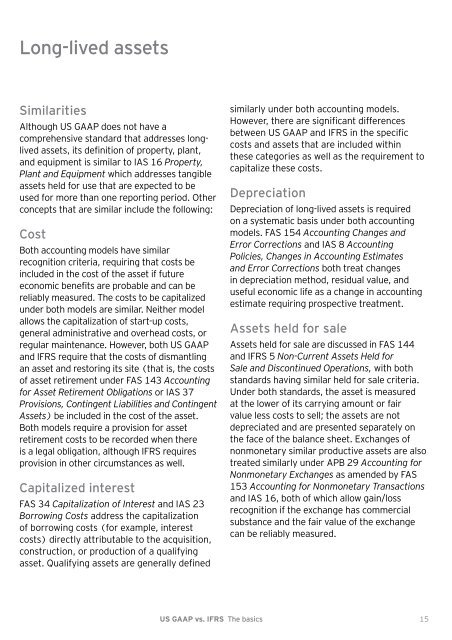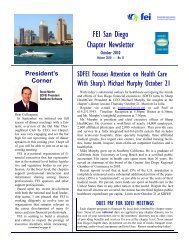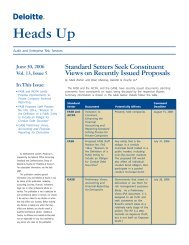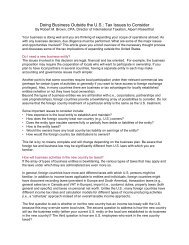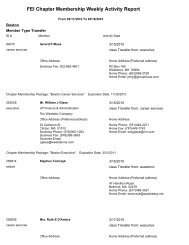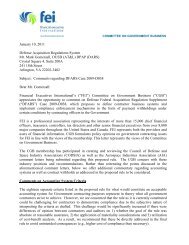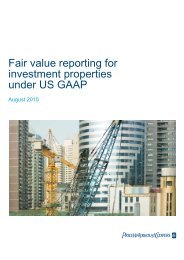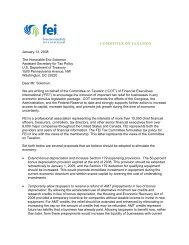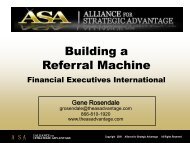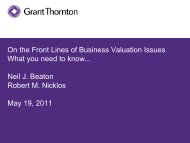US GAAP vs. IFRS The basics - Financial Executives International
US GAAP vs. IFRS The basics - Financial Executives International
US GAAP vs. IFRS The basics - Financial Executives International
You also want an ePaper? Increase the reach of your titles
YUMPU automatically turns print PDFs into web optimized ePapers that Google loves.
Long-lived assets<br />
Similarities<br />
Although <strong>US</strong> <strong>GAAP</strong> does not have a<br />
comprehensive standard that addresses longlived<br />
assets, its definition of property, plant,<br />
and equipment is similar to IAS 1 Property,<br />
Plant and Equipment which addresses tangible<br />
assets held for use that are expected to be<br />
used for more than one reporting period. Other<br />
concepts that are similar include the following:<br />
Cost<br />
Both accounting models have similar<br />
recognition criteria, requiring that costs be<br />
included in the cost of the asset if future<br />
economic benefits are probable and can be<br />
reliably measured. <strong>The</strong> costs to be capitalized<br />
under both models are similar. Neither model<br />
allows the capitalization of start-up costs,<br />
general administrative and overhead costs, or<br />
regular maintenance. However, both <strong>US</strong> <strong>GAAP</strong><br />
and <strong>IFRS</strong> require that the costs of dismantling<br />
an asset and restoring its site (that is, the costs<br />
of asset retirement under FAS 1 3 Accounting<br />
for Asset Retirement Obligations or IAS 37<br />
Provisions, Contingent Liabilities and Contingent<br />
Assets) be included in the cost of the asset.<br />
Both models require a provision for asset<br />
retirement costs to be recorded when there<br />
is a legal obligation, although <strong>IFRS</strong> requires<br />
provision in other circumstances as well.<br />
Capitalized interest<br />
FAS 3 Capitalization of Interest and IAS 23<br />
Borrowing Costs address the capitalization<br />
of borrowing costs (for example, interest<br />
costs) directly attributable to the acquisition,<br />
construction, or production of a qualifying<br />
asset. Qualifying assets are generally defined<br />
<strong>US</strong> <strong>GAAP</strong> <strong>vs</strong>. <strong>IFRS</strong> <strong>The</strong> <strong>basics</strong><br />
similarly under both accounting models.<br />
However, there are significant differences<br />
between <strong>US</strong> <strong>GAAP</strong> and <strong>IFRS</strong> in the specific<br />
costs and assets that are included within<br />
these categories as well as the requirement to<br />
capitalize these costs.<br />
Depreciation<br />
Depreciation of long-lived assets is required<br />
on a systematic basis under both accounting<br />
models. FAS 15 Accounting Changes and<br />
Error Corrections and IAS 8 Accounting<br />
Policies, Changes in Accounting Estimates<br />
and Error Corrections both treat changes<br />
in depreciation method, residual value, and<br />
useful economic life as a change in accounting<br />
estimate requiring prospective treatment.<br />
Assets held for sale<br />
Assets held for sale are discussed in FAS 1<br />
and <strong>IFRS</strong> 5 Non-Current Assets Held for<br />
Sale and Discontinued Operations, with both<br />
standards having similar held for sale criteria.<br />
Under both standards, the asset is measured<br />
at the lower of its carrying amount or fair<br />
value less costs to sell; the assets are not<br />
depreciated and are presented separately on<br />
the face of the balance sheet. Exchanges of<br />
nonmonetary similar productive assets are also<br />
treated similarly under APB 29 Accounting for<br />
Nonmonetary Exchanges as amended by FAS<br />
153 Accounting for Nonmonetary Transactions<br />
and IAS 1 , both of which allow gain/loss<br />
recognition if the exchange has commercial<br />
substance and the fair value of the exchange<br />
can be reliably measured.<br />
15


